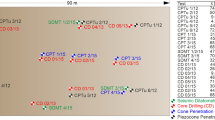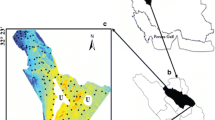Abstract
Integrating borehole and piezocone penetration test (CPTU) data in site characterization helps to achieve a more comprehensive understanding of ground conditions. However, soil types at CPTU and nearby borehole locations may not always be consistent. The presence of noisy data or thin layers will mislead the interpretation of CPTU data in soil type classification and soil property evaluation. This study proposes a coupled machine learning method to integrate the borehole and CPTU data under a rigorous Bayesian framework and to identify and separate the noisy CPTU data without subjective judgment, which contributes to more reliable soil classification and property evaluation. The borehole-reported soil type and CPTU data are treated as two types of evidence of the authentic soil type. A lateral transition of soil type from the CPTU location to the borehole location is allowed to capture the discrepancy of soil types. The proposed approach is applied to the marine site characterization of the Hong Kong-Zhuhai-Macao Bridge that crosses the Pearl River Estuary of China. The soil seams embedded in the dominant soil strata are successfully detected, producing a more reliable soil profile and interpreting more compatible soil properties with engineering practice. Additionally, the integration of borehole and CPTU data significantly reduces the stratification uncertainty in site characterization.













Similar content being viewed by others
References
Bishop CM (2006) Pattern recognition and machine learning. Springer-Verlag, Berlin, Heidelberg
Boulanger RW, DeJong JT (2018) Inverse filtering procedure to correct cone penetration data for thin-layer and transition effects. In: Proc of the 4th Int'l Symp on Cone Penetration Testing (CPT’18), p 25–44
British Standards Institution (BSI) (2010) BS 5930:1999+A2:2010 - code of practice for site investigations. British Standards Institution, London
Cai GJ, Zou HF, Liu SY, Puppala AJ (2017) Random field characterization of CPTU soil behavior type index of Jiangsu quaternary soil deposits. Bull Eng Geol Environ 76:353–369. https://doi.org/10.1007/s10064-016-0854-x
Cao ZJ, Zheng S, Li DQ, Phoon KK (2019) Bayesian identification of soil stratigraphy based on soil behaviour type index. Can Geotech J 56(4):570–586. https://doi.org/10.1139/cgj-2017-0714
Celeux G, Forbes F, Peyrard N (2003) EM procedures using mean field-like approximations for Markov model-based image segmentation. Pattern Recognit 36:131–144. https://doi.org/10.1016/S0031-3203(02)00027-4
Ching JY, Wang JS, Juang CH, Ku CS (2015) Cone penetration test (CPT)-based stratigraphic profiling using the wavelet transform modulus maxima method. Can Geotech J 52(12):1993–2007. https://doi.org/10.1139/cgj-2015-0027
Depina I, Le TMH, Eiksund G, Strøm P (2016) Cone penetration data classification with Bayesian Mixture Analysis. Georisk 10(1):27–41. https://doi.org/10.1080/17499518.2015.1072637
Du Y, Zhu L, Zou H, Zhang L, Cai G, Liu S (2020) Evaluation of CPTU-based soil classification charts for offshore sediments in Pearl River Delta, China. In: Geo-Congress 2020: Modeling, Geomaterials, and Site Characterization (GSP 317), p 663–639. https://doi.org/10.1061/9780784482803.067
Elfeki AMM, Dekking FM (2005) Modelling subsurface heterogeneity by coupled Markov chains: directional dependency, Walther’s law and entropy. Geotech Geol Eng 23(6):721–756. https://doi.org/10.1007/s10706-004-2899-z
Forbes F, Peyrard N (2003) Hidden Markov random field model selection criteria based on mean field-like approximations. IEEE Trans Pattern Anal Mach Intell 25(9):1089–1101. https://doi.org/10.1109/TPAMI.2003.1227985
Gong W, Tien YM, Juang CH, Martin JR, Luo Z (2017) Optimization of site investigation program for improved statistical characterization of geotechnical property based on random field theory. Bull Eng Geol Environ 76(3):1021–1035. https://doi.org/10.1007/s10064-016-0869-3
Hodge V, Austin J (2004) A survey of outlier detection methodologies. Artif Intell Rev 22(2):85–126. https://doi.org/10.1023/B:AIRE.0000045502.10941.a9
Hu ZN, Xie YL, Wang J (2015) Challenges and strategies involved in designing and constructing a 6 km immersed tunnel: a case study of the Hong Kong-Zhuhai-Macao Bridge. Tunn Undergr Sp Tech 50:171–177. https://doi.org/10.1016/j.tust.2015.07.011
Knuuti M, Länsivaara T (2019) Variation of CPTu-based transformation models for undrained shear strength of Finnish clays. Georisk 13(4):262–270. https://doi.org/10.1080/17499518.2019.1644525
Lee KM, Ng PCC (1999) A geotechnical investigation of marine deposits in a nearshore seabed for land reclamation. Can Geotech J 36:981–1000. https://doi.org/10.1139/t99-063
Li A, Jafari NH, Tsai FTC (2020) Modelling and comparing 3-D soil stratigraphy using subsurface borings and cone penetrometer tests in coastal Louisiana, USA. Georisk 14(2):158–176. https://doi.org/10.1080/17499518.2019.1637528
Li DQ, Qi XH, Cao ZJ, Tang XS, Phoon KK, Zhou CB (2016a) Evaluating slope stability uncertainty using coupled Markov chain. Comput Geotech 73:72–82. https://doi.org/10.1016/j.compgeo.2015.11.021
Li DQ, Xiao T, Cao ZJ, Zhou CB, Zhang LM (2016b) Enhancement of random finite element method in reliability analysis and risk assessment of soil slopes using Subset Simulation. Landslides 13(2):293–303. https://doi.org/10.1007/s10346-015-0569-2
Li JH, Cassidy MJ, Huang J, Zhang LM, Kelly R (2016c) Probabilistic Identification of Soil Stratification Géotechnique 66(1):16–26. https://doi.org/10.1680/jgeot.14.P.242
Li SZ (2009) Markov random field modeling in image analysis. Springer Science & Business Media, London
Lunne T, Robertson PK, Powell JJM (1997) Cone penetration testing in geotechnical practice. Blackie Academic and Professional, London
Mayne PW (2007) Cone penetration testing: a synthesis of highway practice. NCHRP Synthesis 368, Transportation Research Board, Washington, D.C.
Mo P, Marshall AM, Yu H (2017) Interpretation of cone penetration test data in layered soils using cavity expansion analysis. J Geotech Geoenviron Eng 143(1):04016084. https://doi.org/10.1061/(ASCE)GT.1943-5606.0001577
Phoon KK, Kulhawy FH (1999) Characterization of geotechnical variability. Can Geotech J 36(4):612–624. https://doi.org/10.1139/t99-038
Phoon KK (2020) The story of statistics in geotechnical engineering. Georisk 14(1):3–25. https://doi.org/10.1080/17499518.2019.1700423
Robertson PK (1990) Soil classification using the cone penetration test. Can Geotech J 27(1):151–158. https://doi.org/10.1139/t90-014
Robertson PK (2009) Interpretation of cone penetration tests - a unified approach. Can Geotech J 46(11):1337–1355. https://doi.org/10.1139/T09-065
Schneider JA, Randolph MF, Mayne PW, Ramsey NR (2008) Analysis of factors influencing soil classification using normalizing piezocone tip resistance and pore pressure parameters. J Geotech Geoenviron Eng 134(11):1569–1586. https://doi.org/10.1061/(ASCE)1090-0241(2008)134:11(1569)
Wang H, Wang X, Wellmann F, Liang RY (2019a) A Bayesian unsupervised learning approach for identifying soil stratification using cone penetration data. Can Geotech J 56(8):1184–1205. https://doi.org/10.1139/cgj-2017-0709
Wang X, Wang H, Liang RY, Liu X (2019b) A semi-supervised clustering-based approach for stratification identification using borehole and cone penetration test data. Eng Geol 248:102–116. https://doi.org/10.1016/j.enggeo.2018.11.014
Wang Y, Huang K, Cao Z (2013) Probabilistic identification of underground soil stratification using cone penetration tests. Can Geotech J 50(7):766–776. https://doi.org/10.1139/cgj-2013-0004
Xia Z, Jia P, Ma S, Liang K, Shi Y, Waniek JJ (2013) Sedimentation in the Lingdingyang Bay, Pearl River Estuary. Southern China J Coastal Res 66(SP1):12–24. https://doi.org/10.2112/SI_66_2
Xiao T, Li DQ, Cao ZJ, Au SK, Phoon KK (2016) Three-dimensional slope reliability and risk assessment using auxiliary random finite element method. Comput Geotech 79:146–158. https://doi.org/10.1016/j.compgeo.2016.05.024
Xiao T, Li DQ, Cao ZJ, Zhang LM (2018) CPT-based probabilistic characterization of three-dimensional spatial variability using MLE. J Geotech Geoenviron Eng 144(5):04018023. https://doi.org/10.1061/(ASCE)GT.1943-5606.0001875
Xiao T, Zhang LM, Li XY, Li DQ (2017) Probabilistic stratification modeling in geotechnical site characterization. ASCE-ASME J Risk Uncertain Eng Syst – A Civ Eng 3(4):04017019. https://doi.org/10.1061/AJRUA6.0000924
Yahşi BK, Ersoy H (2021) Effect of mineralogical composition related to profile depth on index and strength properties of regolith soil. Bull Eng Geol Environ 80(2):1791–1808. https://doi.org/10.1007/s10064-020-01968-8
Yin KS, Zhang LM, Wang HJ, Zou HF, Li JH (2021) Marine soil behaviour classification using piezocone penetration test (CPTu) and borehole records. Can Geotech J 58(2):190–199. https://doi.org/10.1139/cgj-2019-0571
Yuen KV, Mu HQ (2012) A novel probabilistic method for robust parametric identification and outlier detection. Probabilistic Eng Mech 30:48–59. https://doi.org/10.1016/j.probengmech.2012.06.002
Zhao T, Hu Y, Wang Y (2018) Statistical interpretation of spatially varying 2D data from sparse measurements using Bayesian compressive sampling. Eng Geol 246:162–175. https://doi.org/10.1016/j.enggeo.2018.09.022
Zhao T, Wang Y (2019) Determination of efficient sampling locations in geotechnical site characterization using information entropy and Bayesian compressive sampling. Can Geotech J 56:1622–1637. https://doi.org/10.1139/cgj-2018-0286
Zhao T, Xu L, Wang Y (2020) Fast non-parametric simulation of 2D multi-layer cone penetration test (CPT) data without pre-stratification using Markov Chain Monte Carlo simulation. Eng Geol 273:105670. https://doi.org/10.1016/j.enggeo.2020.105670
Zheng S, Zhu YX, Li DQ, Cao ZJ, Deng QX, Phoon KK (2021) Probabilistic outlier detection for sparse multivariate geotechnical site investigation data using Bayesian learning. Geosci Front 12(1):425–439. https://doi.org/10.1016/j.gsf.2020.03.017
Zhou XP, Zhu BZ, Juang CH, Wong LNY (2019) A stability analysis of a layered-soil slope based on random field. Bull Eng Geol Environ 78(4):2611–2625. https://doi.org/10.1007/s10064-018-1266-x
Zou HF, Liu SY, Cai GJ, Puppala AJ, Bheemasetti T (2017) Multivariate correlation analysis of seismic piezocone penetration (SCPTU) parameters and design properties of Jiangsu quaternary cohesive soils. Eng Geol 228:11–38. https://doi.org/10.1016/j.enggeo.2017.07.005
Acknowledgements
This work was supported by Eunsung O&C Offshore Marine and Construction (Project No. EUNSUNG19EG01) and the Science and Technology Plan of Shenzhen, China (Project No. JCYJ20180507183854827).
Author information
Authors and Affiliations
Corresponding author
Ethics declarations
Competing interests
The authors declare no competing interests.
Additional information
Highlights
• A coupled machine learning method is proposed to integrate borehole and CPTU data under a rigorous Bayesian framework.
• A lateral transition of soil type from the CPTU location to the borehole location is allowed to capture the discrepancy of soil types.
• The method is applied to the marine site characterization of the Hong Kong-Zhuhai-Macao Bridge.
• Noisy CPTU data are filtered to achieve more reliable soil type classification and soil property evaluation.
• The integration of borehole and CPTU data significantly reduces the stratification uncertainty.
Rights and permissions
About this article
Cite this article
Xiao, T., Zou, HF., Yin, KS. et al. Machine learning-enhanced soil classification by integrating borehole and CPTU data with noise filtering. Bull Eng Geol Environ 80, 9157–9171 (2021). https://doi.org/10.1007/s10064-021-02478-x
Received:
Accepted:
Published:
Issue Date:
DOI: https://doi.org/10.1007/s10064-021-02478-x




